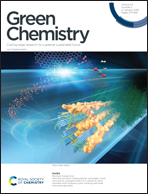Solvent effect on xylose conversion under catalyst-free conditions: insights from molecular dynamics simulation and experiments†
Abstract
In this study, experiments and molecular dynamics simulations were combined to get insights into the role of solvent during the process of xylose conversion under catalyst-free conditions. Solvents used for furfural production were comparatively discussed, including traditional and emerging biomass-derived solvents – water, dimethyl sulfoxide (DMSO), dimethyl formamide (DMF), isopropanol (ISO), γ-butyrolactone (GBL) and γ-valerolactone (GVL). The degradation behavior of solvents, the solubility and α/β ratio of xylose, the distribution of the solvent around xylose/furfural and the hydrogen bonding between them were also studied. The results showed that in pure solvents, the different hydrogen bonding between xylose and the solvent resulted in different products. Water was a favourable solvent for xylose to form furfural among these pure solvents because less formic acid was produced from xylose in water under catalyst-free conditions. Furfural could be produced in mixed solvents if there was more water around xylose, which was similar to the case in pure water. Otherwise, the situation in mixed solvents was similar to that in the corresponding pure organic solvents. GBL and GVL, as green solvents, had weaker affinities with xylose than DMSO, DMF and ISO, but were intensively attracted by furfural, thus they could provide protective shells for furfural, which played a positive role during the production of furfural. The highest furfural yield of 46.4% was achieved in GBL–H2O at 180 °C – 150 min in the absence of catalysts.



 Please wait while we load your content...
Please wait while we load your content...